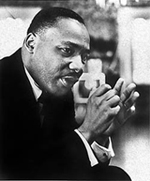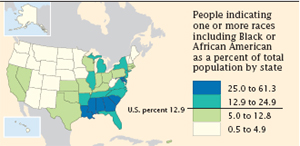Background
·
African
American Experience
· African
American World
·
Africans
in America: America's Journey through Slavery
·
The
Amistad Revolt
·
Black
American Literature at Year 2000
·
Brown
vs. Board of Education: The Supreme Court Decision that Changed
a Nation
·
Civil
Rights: An Overview of Civil Rights & Related Supreme Court
Decisions in the U.S
·
Civil
Rights Movement and the Legacy of Martin Luther King, Jr.
· Civil
Rights Timeline
·
Diversity
in the U.S.
·
The
Martin Luther King, Jr. Center for Nonviolent Social Change
·
Nation
Celebrates Anniversary Of Landmark Civil Rights Law
·
Nation feiert 40. Jahrestag
des Bürgerrechtsgesetzes
· National
Association for the Advancement of Colored People (NAACP)
· National
Urban League
· New
York Times >Topics> Race
· Our
Shared History. African-American Heritage
· Outline
of American History
· Portrait
of America
· Racial
Justice. ACLU
Original
Documents
·
13th
Amendment to the U.S. Constitution: Abolition of Slavery (1865)
· 14th
Amendment to the U.S. Constitution: Civil Rights (1868)
· 15th
Amendment to the U.S. Constitution: Voting Rights (1870)
·
African-American
Texts Online
·
Basic
Readings in U.S. Democracy: On the Road from Slavery to Freedom
·
Brown
vs. Board of Education (1954)
·
Civil
Rights Act (1964)
· Emancipation
Proclamation (1863)
·
Famous Speeches
·
"I Have a Dream"
·
"Ich
habe einen Traum"
· Martin
Luther King, Jr. Speeches
· North
American Slave Narratives
· Official
Program for the March on Washington (1963)
· Say
it Plain. A century of African American Speeches
· Voting
Rights Act (1965)
· Voices
of Civil Rights
Multimedia
· Afircan
American History and Culture
· Being
a Black Man (Wash. Post)
· Ex-Slaves
Narratives
· History
Channel: MLKing<Jr
· History
Channel: Voices of Civil Rights
· Malcolm
X Speaks on Race
·
Race: Are we so different
· Say
It Plain. A Century of Great African American Speeches
· Underground
Railroad
Statistics
·
Black
Population in the United States
·
The
Black Population 2000
·
The
Black Population in the U.S.: March 2002
·
Facts
for Features *Special Edition* Civil Rights Act of 1964: 40th
Anniversary
·
Facts
for Features: African American Heritage Month, February 2010
·
Facts
on the Black/African American Population
·
Historical
Census Statistics On Population By Race, 1790 to 1990, and By
Hispanic Origin, 1970 to 1990
·
We
the People: Black Population in the United States
Exhibits
- Digital Images
·
African-American
Mosaic: African-American Culture and History
·
Anacostia Museum
·
Exploring African
American Heritage
·
National
Civil Rights Museum
·
National Museum of African American
History and Culture
·
National Underground Railroad
Freedom Center
·
Powerful
Days in Black and White
·
Race: Are we so different
· We
Shall Overcome: History Places of the Civil Rights Movement
For
High School Students
· Civil
Rights in America
· Equality
Before the Law
· Martin
L. King Jr.. Interactive Classroom
· Meet
Amazing Americans: Frederick
Douglas, W.E.B.
du Bois, Duke
Ellington, Harriet
Tubman, Langston
Hughes
·
|
|
Among
the flood of immigrants to North America, one group came unwillingly.
These were Africans, 500,000 of whom were brought over as slaves between
1619 and 1808, when importing slaves into the United States became illegal.
The practice of owning slaves and their descendants continued, however,
particularly in the agrarian South, where many laborers were needed
to work the fields.
The process of ending slavery began in April 1861 with the outbreak
of the American Civil War between the free states of the North and the
slave states of the South, 11 of which had left the Union. On January
1, 1863, midway through the war, President Abraham Lincoln issued the
Emancipation Proclamation, which abolished slavery in those states that
had seceded. Slavery was abolished throughout the United States with
the passage of the Thirteenth Amendment to the country's Constitution
in 1865.
Even after the end of slavery, however, American blacks were hampered
by segregation and inferior education. In search of opportunity, African
Americans formed an internal wave of immigration, moving from the rural
South to the urban North. But many urban blacks were unable to find
work; by law and custom they had to live apart from whites, in run-down
neighborhoods called ghettos.
In the late 1950s and early 1960s, African Americans, led by Dr. Martin
Luther King, Jr., used boycotts, marches, and other forms of nonviolent
protest to demand equal treatment under the law and an end to racial
prejudice.
A high point of this civil rights movement came on August 28, 1963,
when more than 200,000 people of all races gathered in front of the
Lincoln Memorial in Washington, D.C., to hear King say: "I have
a dream that one day on the red hills of Georgia the sons of former
slaves and the sons of former slave-holders will be able to sit down
together at the table of brotherhood....I have a dream that my four
little children will one day live in a nation where they will not be
judged by the color of their skin, but by the content of their character."
Not long afterwards the U.S. Congress passed laws prohibiting discrimination
in voting, education, employment, housing, and public accommodations.
 |
| Photo
by Lloyd Wolf for the U.S. Census Bureau |
Today,
African Americans constitute about
13.5 percent of the total U.S. population. In recent decades blacks
have made great strides, and the black middle class has grown substantially.
In 2002, 50,8
percent of employed blacks held "white-collar" jobs --
managerial, professional, and administrative positions rather than service
jobs or those requiring manual labor. In 2003, 58.3 percent of all black
high school graduates enrolled in college within one year (compared
to 35.8. % in 1982). For whites, the college participation rate in 2003
was 66.1 percent. Thus, the racial gap was less than 8 percentage points.
The average income of blacks is still lower than that of whites, however,
and unemployment of blacks -- particularly of young men -- remains higher
than that of whites. And many black Americans are still trapped by poverty
in urban neighborhoods plagued by drug use and crime.
In recent years the focus of the civil rights debate has shifted. With
antidiscrimination laws in effect and blacks moving steadily into the
middle class, the question has become whether or not the effects of
past discrimination require the government to take certain remedial
steps. Called "affirmative action," these steps may include
hiring a certain number of blacks (or members of other minorities) in
the workplace, admitting a certain number of minority students to a
school, or drawing the boundaries of a congressional district so as
to make the election of a minority representative more likely. The public
debate over the need, effectiveness, and fairness of such programs became
more intense in the 1990s.
In
any case, perhaps the greatest change in the past few decades has been
in the attitudes of America's white citizens. More than a generation
has come of age since King's "I Have a Dream" speech. Younger
Americans in particular exhibit a new respect for all races, and there
is an increasing acceptance of blacks by whites in all walks of life
and social situations.
See also:
About the USA > U.S. History > Decades
of Change
About the USA > Holidays > Martin
Luther King Day
|
|
Identity
in America: Are Perspectives Shifting?
Multicultural, post-ethnic, post-racial. While these descriptors are
debated, most agree that with the possible exception of the American
Indian, to be American is to be, genealogically speaking, from somewhere
else. During February, America.gov is exploring how the ever-increasing
diversity of the U.S. ... (America.gov, 29 January 2009)
Landmark
Exhibit on Race Asks “Are We So Different?”
Is race real or a recent human invention? Is it about biology or culture?
These questions are addressed by RACE: Are We So Different?, a traveling
exhibit and related Web site on the history of the idea of race, the
science of human variation, and the experience of living with race and
racism. ... (America.gov, 28 January 2009) - "Race:
Are we so different" Web Site
Black
History Month Honors Legacy of Struggle and Triumph
John Fleming, head of black history study group, tells America.gov Black
History Month should focus on positive and negative aspects of the black
experience. “We were not slaves prior to being captured in Africa, and
while slavery was part of our experience … we have a hundred-and-some
years in freed ... (America.gov, 29 January 2009)
Americans
Celebrate Achievements of Martin Luther King Jr.
Americans on the third Monday of January honor the life and achievements
of the Reverend Martin Luther King Jr. (1929-1968), the 1964 Nobel Peace
laureate, a champion of universal justice, and the individual most associated
with the triumphs of the civil rights movement during the 1950s and
1960s. ... (America.gov, 14 January 2009)
"A
More Perfect Union"
In his first detailed discussion of race in America in this Philadelphia
speech on March 18, 2008, Obama expresses his “firm conviction” that,
in working together, Americans of all color can move beyond some of
the old racial wounds. He asserts that, in fact, Americans have no choice
if they are to c ... (America. gov, 11 January 2009)
U.S.
Minority Population Continues to Grow. By David Minckler
Slightly more than one-third of the population of the United States
-- 34 percent -- claims minority, racial or ethnic heritage, a jump
of 11 percent from 2000.
The
May 1, 2008 Census Bureau report, covering estimates for the year
2007, confirms that the U.S. population is becoming increasingly diverse.
Hispanics and Asians continue to be the two fastest-growing minorities.
Blacks comprise the second-largest minority group, with 40.7 million
(13.5 percent), followed by Asians, with 15.2 million (5 percent). (America.gov,
May 14, 2008.) |
Beyond
Dr. King: More Stories of African-American Achievements
- A Living Book
Obama
in His Own Words (January
2009)
These pages share President Obama’s words with our global readership.
This book includes the complete text of the 44th President’s Inaugural
Address. Also featured are extended excerpts from eight other significant
campaign and pre-presidential speeches.
Barack
Obama: 44th President of the United States (January
2009.)
Barack Obama, elected the 44th President of the United States, has lived
a truly American life, and has opened a new chapter in American politics.
This publication tells the story of Obama’s life, describes how he captured
the presidency, and portrays his vision for the future.
FREE
AT LAST: The U.S. Civil Rights Movement. (February
2008.)
This publication tells the story of the African-American civil rights
movement in the United States, as well as of its roots in the historical
injustices of slavery and segregation.
Justice
for All: The Legacy of Thurgood Marshall. (January
2007.)
The name of Thurgood Marshall may not be as well-known outside the United
States as that of his fellow civil rights leader, Martin Luther King
Jr. And yet, Marshall's achievement in demolishing the legal structure
that sustained racial segregation in the American South advanced the
civil rights cause as profoundly as the nonviolent protests led by King.
|





